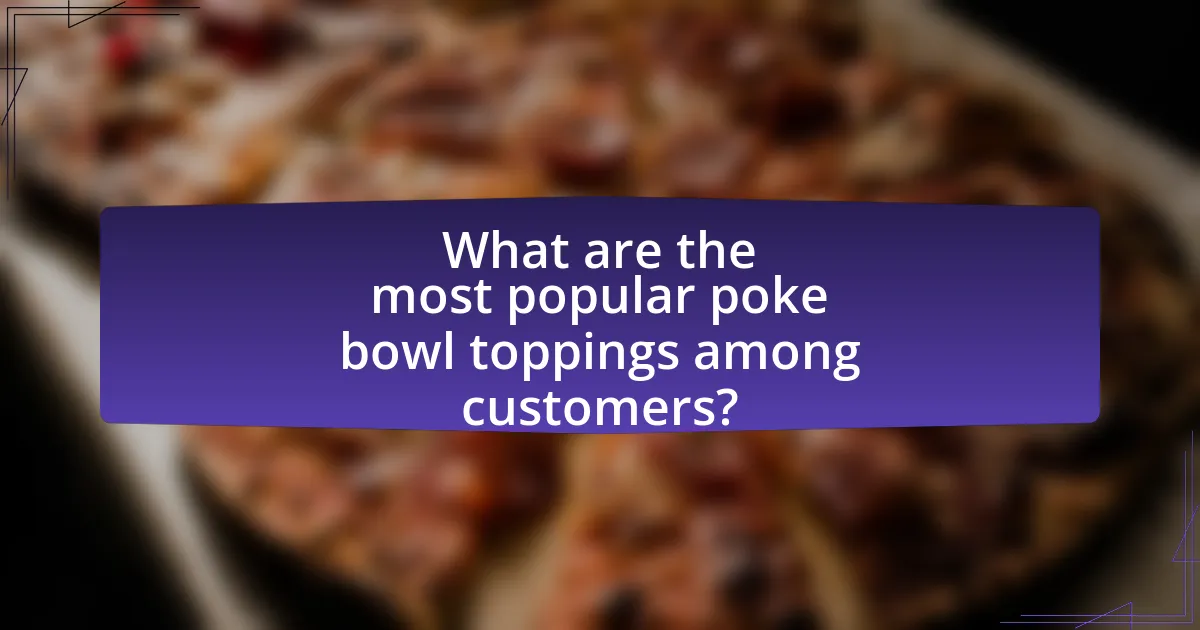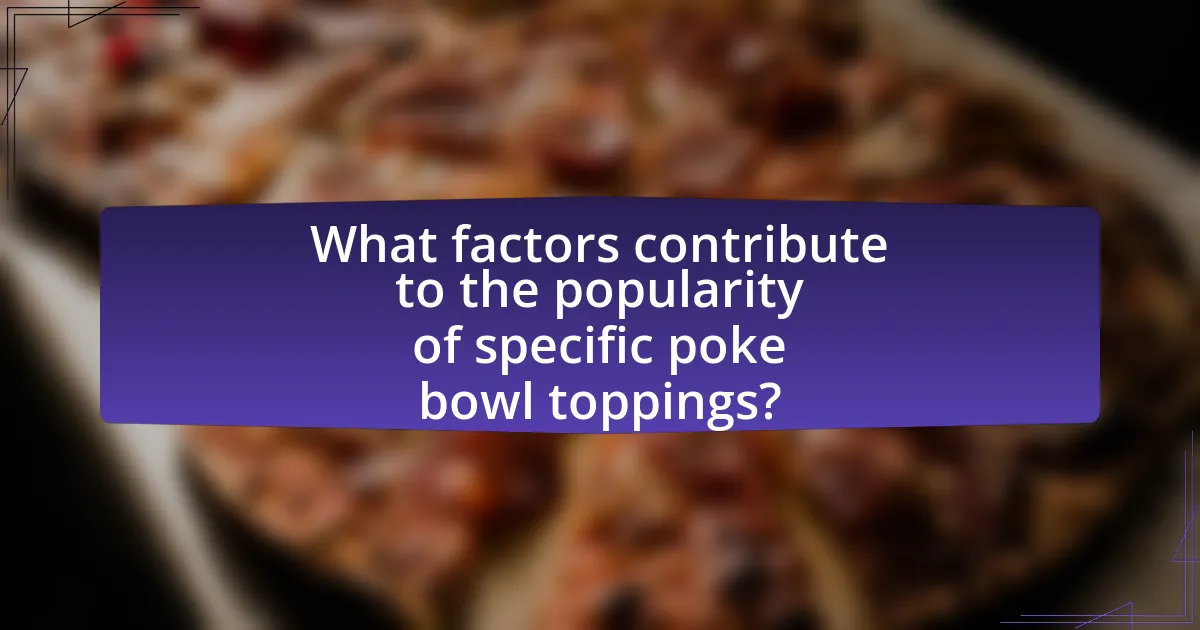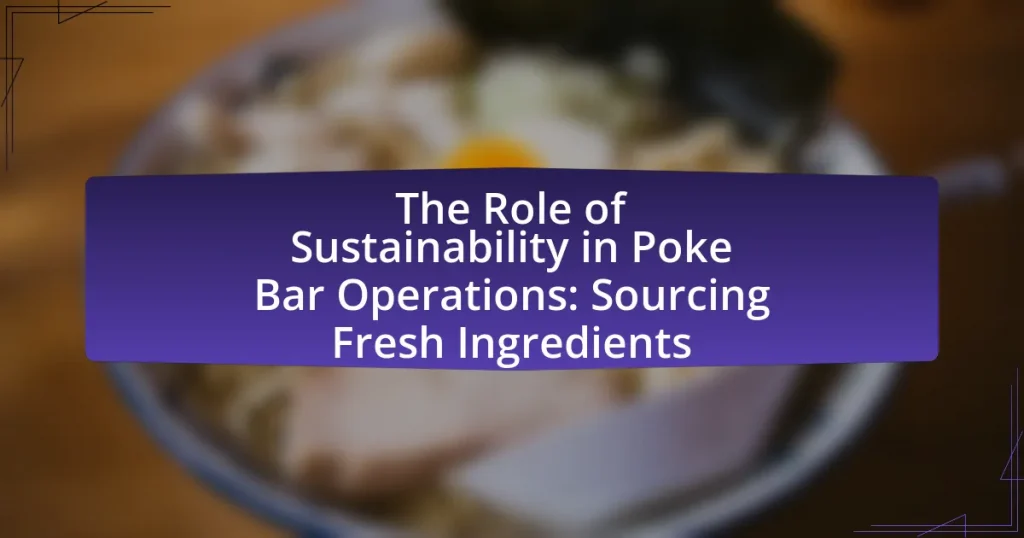The article focuses on analyzing customer preferences for poke bowl toppings, identifying popular choices such as avocado, seaweed salad, spicy mayo, salmon, and tuna. It explores how demographics, including age and cultural background, influence topping selections, revealing trends among different age groups and regions. Additionally, the article discusses the impact of health trends, ingredient freshness, and marketing strategies on consumer choices, while highlighting the importance of customer feedback and effective menu design in shaping topping offerings. Overall, it provides a comprehensive overview of the factors that contribute to the popularity of specific poke bowl toppings.

What are the most popular poke bowl toppings among customers?
The most popular poke bowl toppings among customers include avocado, seaweed salad, spicy mayo, and various types of fish such as salmon and tuna. Avocado is favored for its creamy texture and health benefits, while seaweed salad adds a unique flavor and nutritional value. Spicy mayo is commonly chosen for its ability to enhance the overall taste profile of the bowl. Additionally, salmon and tuna are preferred proteins due to their freshness and rich flavors, making them staples in many poke bowls. These preferences are supported by surveys and sales data from poke bowl restaurants, indicating consistent trends in customer choices.
How do customer demographics influence topping preferences?
Customer demographics significantly influence topping preferences in poke bowls, as factors such as age, gender, and cultural background shape individual tastes. For instance, younger consumers often prefer trendy toppings like spicy tuna or avocado, while older demographics may lean towards traditional options such as salmon or seaweed. Additionally, cultural influences play a crucial role; for example, Asian-American customers might favor toppings like edamame or pickled ginger, reflecting their heritage. Research indicates that 60% of millennials prioritize unique and bold flavors in their food choices, which directly impacts their topping selections. Thus, understanding these demographic trends allows businesses to tailor their offerings to meet the specific preferences of different customer segments.
What age groups prefer specific poke bowl toppings?
Younger age groups, particularly those aged 18-34, tend to prefer poke bowl toppings such as spicy tuna, avocado, and mango, reflecting a trend towards bold and fresh flavors. In contrast, older age groups, specifically those aged 35 and above, often favor more traditional toppings like salmon, seaweed salad, and cucumber, indicating a preference for classic and familiar tastes. This distinction in topping preferences is supported by market research that shows younger consumers are more adventurous in their food choices, while older consumers prioritize comfort and familiarity in their dining experiences.
How does location affect topping choices?
Location significantly influences topping choices for poke bowls due to regional culinary preferences and ingredient availability. For instance, coastal areas often favor seafood toppings like ahi tuna and salmon, reflecting local fishing practices and cultural inclinations towards fresh fish. In contrast, inland regions may lean towards more land-based toppings such as chicken or tofu, as these ingredients are more accessible and align with local dietary habits. Additionally, cultural diversity in urban areas can lead to a wider variety of toppings, including unique sauces and garnishes that cater to different ethnic cuisines. This regional variation in topping preferences is supported by market research indicating that consumer choices are heavily shaped by local food trends and ingredient sourcing.
What are the top trending poke bowl toppings currently?
The top trending poke bowl toppings currently include avocado, spicy tuna, seaweed salad, mango, and edamame. Avocado is favored for its creamy texture and health benefits, while spicy tuna has gained popularity due to its bold flavor profile. Seaweed salad adds a unique taste and nutritional value, and mango provides a sweet contrast to savory ingredients. Edamame is often chosen for its protein content and crunchy texture. These toppings reflect current consumer preferences for fresh, flavorful, and nutritious options in poke bowls.
Which toppings have seen a rise in popularity recently?
Recently, toppings such as avocado, spicy tuna, and mango have seen a rise in popularity among poke bowl enthusiasts. Avocado has become a favored choice due to its creamy texture and health benefits, while spicy tuna has gained traction for its bold flavor profile. Additionally, mango adds a sweet contrast that appeals to many consumers. According to a survey conducted by the National Restaurant Association in 2023, these toppings were highlighted as trending choices in various poke bowl establishments, reflecting changing customer preferences towards fresher and more vibrant ingredients.
What toppings are considered classic favorites?
Classic favorite toppings for poke bowls include avocado, seaweed salad, cucumber, and spicy mayo. These toppings are widely recognized for their popularity among customers, often enhancing the flavor and texture of the dish. Avocado adds creaminess, seaweed salad provides a savory umami flavor, cucumber contributes a refreshing crunch, and spicy mayo offers a creamy, spicy kick. Their frequent inclusion in poke bowl menus across various restaurants supports their status as classic favorites.
Why do certain toppings appeal more to customers?
Certain toppings appeal more to customers due to their flavor profiles, health benefits, and cultural significance. For instance, toppings like avocado and spicy tuna are favored for their rich taste and nutritional value, as they provide healthy fats and protein. Additionally, toppings that reflect cultural trends, such as kimchi or seaweed, resonate with customers seeking authentic culinary experiences. Research indicates that 70% of consumers prefer toppings that enhance the overall flavor and texture of their meals, demonstrating a clear link between topping selection and customer satisfaction.
What flavor profiles are most sought after in poke bowl toppings?
The most sought-after flavor profiles in poke bowl toppings include umami, sweetness, and spiciness. Umami flavors are often derived from ingredients like soy sauce, seaweed, and fish, which enhance the overall taste experience. Sweetness is commonly added through toppings such as mango or sweet sauces, providing a contrast to savory elements. Spiciness is frequently introduced via ingredients like spicy mayo or jalapeños, appealing to those who enjoy heat in their meals. These flavor profiles align with consumer preferences for balanced and diverse taste experiences in poke bowls, as indicated by market research showing a growing demand for complex flavor combinations in contemporary cuisine.
How do health trends impact topping selections?
Health trends significantly influence topping selections by driving consumer preferences towards healthier, nutrient-dense options. For instance, the rise in popularity of plant-based diets has led to increased demand for toppings like avocado, edamame, and various vegetables, as consumers seek to incorporate more greens and proteins from non-animal sources. Additionally, the growing awareness of dietary restrictions, such as gluten-free and low-carb diets, has prompted customers to choose toppings that align with these health-conscious choices, such as quinoa or cauliflower rice. Research indicates that 70% of consumers are more likely to choose a meal based on its health benefits, reinforcing the impact of health trends on topping selections in poke bowls.

What factors contribute to the popularity of specific poke bowl toppings?
The popularity of specific poke bowl toppings is influenced by flavor profiles, health trends, and cultural authenticity. Flavor profiles attract customers seeking a balance of savory, sweet, and umami tastes, with ingredients like avocado and spicy mayo enhancing overall appeal. Health trends drive demand for toppings that are perceived as nutritious, such as seaweed, edamame, and fresh vegetables, aligning with consumer preferences for healthier eating. Cultural authenticity also plays a significant role, as traditional toppings like raw fish and sesame seeds resonate with customers looking for an authentic poke experience. These factors collectively shape customer choices and preferences in poke bowl toppings.
How does the freshness of ingredients affect customer choices?
The freshness of ingredients significantly influences customer choices by enhancing perceived quality and taste. Fresh ingredients are often associated with higher nutritional value and better flavor, leading customers to prefer dishes that feature them. Research indicates that 70% of consumers prioritize freshness when selecting food options, particularly in health-conscious markets like poke bowls. This preference is supported by studies showing that fresh ingredients can increase customer satisfaction and repeat business, as they contribute to a more enjoyable dining experience.
What role does ingredient sourcing play in topping popularity?
Ingredient sourcing significantly influences topping popularity by determining the quality, freshness, and uniqueness of the ingredients used. High-quality, sustainably sourced ingredients often lead to greater customer satisfaction and loyalty, as consumers increasingly prioritize health and ethical considerations in their food choices. For instance, a study published in the Journal of Food Quality and Preference found that consumers are willing to pay more for toppings made from locally sourced, organic ingredients, which enhances their appeal and popularity. This trend indicates that ingredient sourcing not only affects the taste and presentation of poke bowl toppings but also aligns with consumer values, thereby driving their popularity in the market.
How does the presentation of toppings influence customer preferences?
The presentation of toppings significantly influences customer preferences by enhancing visual appeal and perceived quality. Research indicates that visually attractive food presentations can increase appetite and enjoyment, leading to higher customer satisfaction. For instance, a study published in the journal “Appetite” found that food presented in an aesthetically pleasing manner is often rated as tastier and more desirable, which directly affects purchasing decisions. Therefore, the arrangement, color contrast, and overall visual design of poke bowl toppings can sway customers towards specific choices, ultimately impacting their overall dining experience.
What marketing strategies enhance the appeal of certain toppings?
Effective marketing strategies that enhance the appeal of certain toppings include targeted promotions, social media engagement, and influencer partnerships. Targeted promotions, such as discounts or limited-time offers, create urgency and encourage trial among consumers. Social media engagement allows brands to showcase visually appealing images of poke bowls with specific toppings, tapping into the visual nature of platforms like Instagram, where 70% of users report discovering new products. Influencer partnerships leverage the credibility and reach of popular figures to endorse specific toppings, driving consumer interest and perceived value. These strategies collectively increase visibility and desirability, leading to higher sales and customer satisfaction.
How do promotions and discounts affect topping selection?
Promotions and discounts significantly influence topping selection by incentivizing customers to choose more expensive or premium toppings. Research indicates that when discounts are applied, consumers are more likely to experiment with toppings they might not typically select due to price sensitivity. For example, a study published in the Journal of Marketing Research found that promotional offers can increase the likelihood of customers opting for higher-priced items by up to 30%. This behavior is driven by the perceived value gained from the discount, leading to a broader exploration of available options in poke bowl toppings.
What role does social media play in shaping topping trends?
Social media significantly influences topping trends by facilitating the rapid dissemination of food trends and consumer preferences. Platforms like Instagram and TikTok allow users to share visually appealing content, which can lead to viral popularity of specific poke bowl toppings, such as avocado or spicy tuna. According to a study by the Pew Research Center, 69% of adults in the U.S. use social media, making it a powerful tool for shaping consumer behavior and preferences in the food industry. This visibility encourages restaurants to adapt their menus to include trending toppings, thereby directly impacting what consumers choose to order.

How can businesses leverage customer preferences for poke bowl toppings?
Businesses can leverage customer preferences for poke bowl toppings by utilizing data analytics to identify popular choices and trends among their clientele. By collecting and analyzing sales data, customer feedback, and social media interactions, businesses can determine which toppings are favored, allowing them to tailor their offerings accordingly. For instance, a study by Technomic found that 60% of consumers prefer customizable meals, indicating that providing a variety of popular toppings can enhance customer satisfaction and drive sales. Additionally, businesses can implement loyalty programs that reward customers for trying new toppings, further aligning their menu with customer preferences and increasing engagement.
What strategies can restaurants implement to cater to popular topping choices?
Restaurants can implement strategies such as offering customizable poke bowls, conducting regular surveys to identify trending toppings, and utilizing seasonal ingredients to cater to popular topping choices. Customizable poke bowls allow customers to select their preferred toppings, enhancing satisfaction and engagement. Regular surveys can provide insights into customer preferences, enabling restaurants to adapt their offerings based on real-time data. Additionally, using seasonal ingredients not only keeps the menu fresh but also aligns with consumer trends towards sustainability and local sourcing, which can increase customer loyalty and attract new patrons.
How can menu design influence topping selection?
Menu design significantly influences topping selection by guiding customer choices through visual hierarchy, layout, and descriptive language. For instance, prominently featured toppings at the top of a menu or highlighted with boxes can attract more attention, leading to higher selection rates. Research indicates that items placed in the upper right corner of a menu are often chosen more frequently due to their visibility and perceived importance. Additionally, descriptive language that evokes sensory experiences can enhance the appeal of certain toppings, making them more desirable. This strategic presentation aligns with consumer behavior studies, which show that well-designed menus can increase sales of specific items by up to 30%.
What role does customer feedback play in topping offerings?
Customer feedback plays a crucial role in shaping topping offerings for poke bowls by providing insights into consumer preferences and satisfaction levels. This feedback allows businesses to identify popular toppings, adjust their menu based on customer desires, and enhance overall dining experiences. For instance, a survey conducted by Technomic in 2021 revealed that 70% of consumers are more likely to return to a restaurant that actively seeks and implements customer feedback. By analyzing this data, restaurants can optimize their topping selections to align with customer tastes, ultimately driving sales and customer loyalty.
What are best practices for introducing new poke bowl toppings?
To effectively introduce new poke bowl toppings, conduct thorough market research to understand customer preferences and trends. This involves analyzing existing popular toppings and gathering feedback through surveys or focus groups to identify desired flavors and ingredients. Implementing a limited-time offering can create excitement and urgency, allowing customers to try new toppings without a long-term commitment. Additionally, promoting new toppings through social media and in-store signage can enhance visibility and encourage customer engagement. According to a study by Technomic, 63% of consumers are more likely to try new menu items if they are promoted effectively.
How can businesses test new toppings effectively?
Businesses can test new toppings effectively by conducting controlled taste tests and gathering customer feedback. This approach allows businesses to evaluate the appeal of different toppings in a real-world setting, ensuring that they align with customer preferences. For instance, a study by the Journal of Food Science found that sensory evaluation methods, such as blind taste tests, can significantly influence consumer choices and preferences. By analyzing the data collected from these tests, businesses can make informed decisions about which toppings to introduce based on actual customer responses.
What methods can be used to gather customer preferences on toppings?
Surveys and questionnaires are effective methods to gather customer preferences on toppings. These tools allow businesses to directly ask customers about their topping choices, preferences, and satisfaction levels. For instance, a study by the Journal of Consumer Research indicates that structured surveys can yield quantitative data that helps identify popular toppings among different demographics. Additionally, focus groups can provide qualitative insights, allowing customers to discuss their preferences in detail. Online polls and social media engagement also serve as modern methods to capture real-time customer feedback on topping choices.



